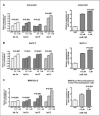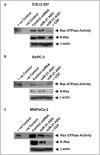RETRACTED: Increased Ras GTPase activity is regulated by miRNAs that can be attenuated by CDF treatment in pancreatic cancer cells
- PMID: 22261338
- PMCID: PMC3326199
- DOI: 10.1016/j.canlet.2012.01.013
RETRACTED: Increased Ras GTPase activity is regulated by miRNAs that can be attenuated by CDF treatment in pancreatic cancer cells
Retraction in
-
Retraction notice to "Increased Ras GTPase activity is regulated by miRNAs that can be attenuated by CDF treatment in pancreatic cancer cells" [Cancer Lett. 319(2) (2012) 173-181].Cancer Lett. 2018 Feb 1;414:313. doi: 10.1016/j.canlet.2017.11.030. Cancer Lett. 2018. PMID: 29277381 Free PMC article. No abstract available.
Abstract
This article has been retracted: please see Elsevier Policy on Article Withdrawal (http://www.elsevier.com/locate/withdrawalpolicy). This article has been retracted at the request of the Editor in Chief. An investigation by Wayne State University identified a discrepancy between the data reported in Figures 1 A and 3 and the original collected data. The investigation committee concluded that this undermined the scientific basis of the publication, that no credible replacement data were available, and advised that the publication should be retracted.
Copyright © 2012 Elsevier Ireland Ltd. All rights reserved.
Figures







References
-
- Friday BB, Adjei AA. K-ras as a target for cancer therapy. Biochim.Biophys.Acta. 2005;1756:127–144. - PubMed
-
- Arvanitakis M, Van Laethem JL, Parma J, De M, V, Delhaye M, Deviere J. Predictive factors for pancreatic cancer in patients with chronic pancreatitis in association with K-ras gene mutation. Endoscopy. 2004;36:535–542. - PubMed
-
- Wang Z, Banerjee S, Ahmad A, Li Y, Azmi AS, Gunn JR, Kong D, Bao B, Ali S, Gao J, Mohammad RM, Miele L, Korc M, Sarkar FH. Activated K-ras and INK4a/Arf deficiency cooperate during the development of pancreatic cancer by activation of Notch and NF-kappaB signaling pathways. PLoS.One. 2011;6:e20537. - PMC - PubMed
-
- Lu J, Getz G, Miska EA, varez-Saavedra E, Lamb J, Peck D, Sweet-Cordero A, Ebert BL, Mak RH, Ferrando AA, Downing JR, Jacks T, Horvitz HR, Golub TR. MicroRNA expression profiles classify human cancers. Nature. 2005;435:834–838. - PubMed
Publication types
MeSH terms
Substances
Grants and funding
LinkOut - more resources
Full Text Sources
Other Literature Sources
Medical
Miscellaneous

